Brief notes from the review, will be edited later, currently they are probably very difficult to understand.
Invited guests: Nate Kolbe, Gustav Fagerström, Andrei Martin, Georgia (?)
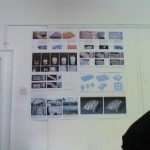
Kyu Dong
Presentation:
research as failed experiments /hydro gel)
Moving on to studies of fibonachi series and pine cones.
Looking at minimal surfaces, sampling from Bentley Architectural Geometry.
Comments:
No differentiation in presentation, low level images, don´t present failures extensively and push own ideas.
How are tests made? The material tests of diaper + metal could never work. Composites in general have a more developed relationship between materials, materials have a physical relationship that is proportional to their strengths.
Looking at saddle surfaces/minimal surfaces, but not pushing how this could be integrated with material research.
Looking for porosity now? Need for better understanding and more rigorous ideas of different hierarchies of material performance. Different lines of enquiry must be aligned and associated.
When a geometry is “found”, a rigorous line of enquiry should be done, looking for potentials in that geometry. Example; minimal surface geometry ha very important material capacity (optimizing surface/volume).
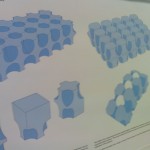
Sharon
Presentation:
Start in superabsorbent polymers. Presenting the material performance of hydro gel. Storing liquid will cool interior space. Controlling evaporation and temperature. Potentially changing wall curvature. Looking at geodesic domes, and applying hydrogel into a system based on this. Alternative is using it inside pistons for opening and closing.
Comments:
Looking for applications that are already existing.
Absorption of water also makes it heavy.
Looking for geometrical principles or structural capacities? – geometry.
Controlling evaporation makes a link to geometry (ie surface area), otherwise the material itself has no geometry, it follows the form of the container. Most materials responds to temperature.
Need to find the drivers for the project and research. Doesn´t work because of scale, or it must be much larger? Composite principles are not considered, should be followed through. Example shown is using the material performance of one material (hydro gel) working with another fabricated material (that makes it into an actuated composite).
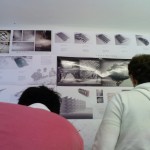
Michael
Presentation (arrived very late):
Different materials in layers, the ability to infuse composites with additional changing performance (nano scale materials). Self-healing material (cut in panels, then reattached on site – why cut in the first place?). Easy to ship materials. Changing material properties from hard to soft. Material performance under stress. Studies on freezing. Woven mesh extended into a 3d woven structure – deep components. Biomimetic polymer soft > hard when it gets wet. Considering Tel Aviv. Using material as a joint, that allows structure to deform as tide comes in.
Flexible structures – flexible or structural?
Fabrication issues. Components that have flexible joints as well as other members (which once are flexible, how is this explored in the design, and how is it controlled in the end?). What software?
Water is heavy, what does it do inside the structure?
Comments:
Tendency not to define what it is supposed to do, but always keep it flexible. What is the value of it all being flexible in an architectural approach? Is it really testing how flexible it is, without physical test? The architectural performance must also be assessed. What defines flexibility, must it move or not? Not justification but direction.
MS: Architecture doesn´t have to move-the project is doing it on a symbolic level.
AY: what are the critical ways of flexibility right now? Structural adaptation, responsive?
JL: issue of component, it has been explored before and must be bringing something new, and add to issues of performance etc.
AY: find the parameters and principles of flexibility.
JR: Flexibility vs Behaviour? Get closer to performance.
NK: physical models are important to test. Milllenium bridge example-too flexible had to be restricted. Time to respond to your own problems.
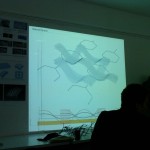
Michal
Presentation:
Start in materials, fire proofing, fibers transmitting light, Weaved materials, ceramics.
Site investigations of South East Baltic coastlines; erosion. Programmatic functions of the site; tourism etc.
Not very much explanation of material system. Woven structure with added other material to make more structural. Easy access to less populated spaces on the shoreline. Some parts are responding to water levels. Showing basically one slide and three models.
Comments:
NK: Models are not advanced enough. How should the weave perform? Use the materials in the weave with intent. Analogy to Dubai palm development? Comp to light performing either as wave or particle, depending on test method. If site is important, it should be used for this purpose. Motivation is external to you presentation. Light piece of work so far, must be pushed much harder. Important to make drawings that explore things. This just isn´t good enough at this stage.
JL: Weaving or not weaving? Look closer at how the material is made, and be open to reconsider if weaving is the way to go. Previous conversation on fabrication and production of racing cars, boats etc.
JR: Scale is an issue, use of different materials, different ways of compositing, different performance; and find out the relation between them.

Jung Joon Yun
Presentation:
Program for leisure center in Spain. Natural fibers, weaving system, way of weaving creates different forms. Good overview of knitting systems. Looping weaving principles. Channelling the air with material system. Getting wind inside the building, supporting ventilation [JR: what are the architectural implications?]. Sports centre with accommodation. Lot of wind on site.
Extensive research in the form of examples that exemplifies bulding performance, but no work to explore it.
GC model?
Comments:
AM: What is the most important thing to do, too many ideas? Low energy building or site specific characteristics-climate, context etc. Using perforation in a hatchet (two big holes) or a scalpel (many small apertures) in order to make the technical performance work.
JR: Also look for other local aspects, material research, producers etc. And find the architectural implications of the technical aspects of the material systems.
NK: You must make much more, produce models and drawings.
Xx: There are many other ways to design composites besides weaving, especially in order to direct air.
AY: the story line is missing, it is doing it but not fully.
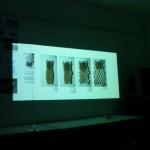
Arya
Presentation:
Site in Istanbul. Durable and elastic material. Technogel. Auxetic structures. Short on climates in sites near Istanbul. Some new models, including a digital two layered one. Changing light inside structure, through change of porosity and affected by external forces. Conceptual link between different site conditions (with differentiation between cultures) and differentiation of spaces(?).
The response to wind/light of structure.
Comments:
AM: Private/public (as in research center) has relation with light and wind? What is the added value of the auxetic structure?
JR: How does wind pull? Must be reinforced. Wind and sound? All material systems need additional materials and parts in order to perform.
JL: A highly modulated system, which is no longer easily understood.
AM: How do you test spatial potential? Iterations necessary, perhaps a series of defined spaces. Three images not enough. Scaffolding is now largely ignored.
AY: rules are very important, focus on what the system is means to do at this time, later it will expand into on a building scale.
JR: Drawings are required in order to understand spatial aspects with material systems.
General question and discussion of material systems, and the need for multiple material systems that are supporting each other.
Claudia
Presentation:
Material qualities studies (all images no annotations). Interest in water flows and velocities, and surfaces that can control them. How are waterflows shifting in the future, and how can a material system respond to this. Ystad / Tel Aviv. Erosion. Aquatic Microorganisms/Radiolaryncs(?). Units operating as water filters, water absorbents etc. Contact with Redding University. Flow networks. Underwater tower rather than surfaces. Research center controls and monitors the material system. At distance, dislocated from material system. Observatories on the coastline and material systems submerged with buoy (referred to as anchors) or similar at water surface, that turns and makes underwater movement visible.
Comments:
JR: making closer connection between different material systems.
JL: great ambition and lots of work presented, makes a nice story. But a pause is needed, an need to go back to revisit parts, and think about how this relates to manufacturing and production. Each slide is an illustration for an idea, doesn´t show a material design development.
JR: Vary advanced programmatic description with architectural qualities as part of the project already, potentially setting the task for the precise development ahead. Can material systems start to interact (not keeping it as device with a technical performance but also as architectural performative systems, and preferably multiple systems working together)
JR: Fabrication/production, diagramming, descriptive information on how it works. The issues of monitoring sea activities as suggested by Mats Brodén, using biomimetic sensory systems. Erosion may not be the only thing monitored and mitigated, and maybe the most extreme current/flow situation is not the best place to test it, but maybe a less extreme situation is better.
AY: What are the specific details of the performance? Material/physical models are necessary. Micro-organisms as references, will operate at completely different scale.
JL: Making of material models, trying to construct system is very important.
Make physical model, at specific scale, using at least two materials.
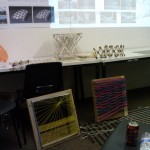
Kengo
Presentation:
Material intro. Site most likely Israel. Fiber/ceramic composites. Refering to compositing also in collaboration/research (based on sthlm trip). Metal weaving, but mmore potential seen in fiber/ceramic compositing. Latex enabled flexible joints. Expansion, compression, bending , twisting. Digital models, + tests in other materials with performance consistent to scale. Looking to remove redundancy of tension cables. Detailed material model studies, with tension cables. Slack an issue, as lack of craftsmanship. Plan to do a large scale model in order to be more precise in materials (latex, fibres, ceramics). Needs site visit for method to specify agenda.
Structure operating in conjunction with natural ventilation; replacing louvers/window openings etc?
Comments:
Lida: Model is too crude, needs to be developed more precisely in order to perform well. More drawings my help understand trajectory.
Maryam: gradient in stiffness.
JR: Tensigrity structures? Added articulation for architectural purposes other than flexible/structural. Need to add materials with multiple capacities/performances.
JL: new models are not using flexible joints.
AY: what is the quality of the space created? Scale needed to defined questions. Thermal behaviour, if important, should be possible to discuss. Or structural loading? Formwork may be useful, perhaps integrated into system.
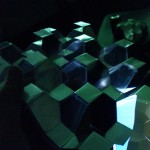
Sakiko
Presentation:
Material research – foamed aluminium. Geometrical principle basis for models. Deformed folded models through variations in cut angels. A series of studies of different variations, including apertures etc.
Comments:
JL: what is the translation into material? > Metal. What are fabrication issues? Can also be formwork, not only working as sheet but also using to cast other materials.
JR: meet a producer and discuss how it can be done rationally. Close to patent. Can sheets of different variations be combined, and how can this material system b e combined with another principle (like orthogonal system)?
TT: Composting materials. Good for variations in structure or other performance?
Lida: Good system with excellent control.
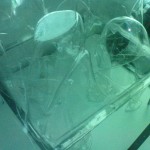
Maryam
Presentation:
Material- 3D veneer. Plastic free-formed with partial moulds or jigs, deformed though gravity. Jig using soap bubbles. Differentiation of jig in 3D. Glass takes 36 hours. Layering plastics with different opacitites, thickness, color etc. Interpretation of framework. Angle of jig before heating makes bug difference. Room or facade scale. Visual deformation (light refraction). Site Istantbul, program unknown, but may work to blur boundaries between cultures etc.
Comments:
Lida: Lack of control, still only fascination of form. Skin or 3d-structure? Intersection of soapbubbles, and dual materials with different overlaps. The wire control for making multiple forms in one may be refined by having more slack.
JR: Jig in analogy with primary structural framework? Machining material before heating, creating differentiation on thickness.
JL: try other materials as well. Time to produce may be too long for industrial use. Scale may be an issue. Application irs very crucial, to look at the next few weeks.
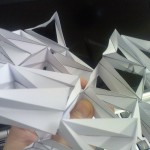
Chi Sung Lee
Presentation:
Material, concrete, perforation, audio blocking. Angles important for audio breakdown. Presenting stacking as a principle (I suggested drop this reference). Trying to find ways of controlling structure.
Comments:
JR: Bottom up principle (one triangle added to another) may not work very well, very hard to control. Perhaps global control is necessary. Look at Tom Wiscombe /Emergent – Dragon fly project for aspects of fabrication.
AY: How do you decide which combination of parts are working better? Impossible to say, since the parameters are missing. Establish simple design parameters. What are the visual and other effects. Scale important.
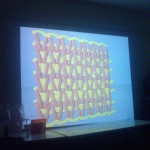
Andreas
Presentation:
Flexible material system. Controlling water passage (?). Was expansion depends on temperature. Rhino screenshots. Ribbing/knitting system. Ribbing directly translated into more structural stability with no other material tests assuming that certain types should have higher structural capacities. Blooming of algae.
Derived from knitting system.
Comments:
JR: material must be formatted. Knitting techniques. You should knit to understand knitting principles. What other activities can be added to bring in an architectural agenda.
Lida: titles to presentation are very helpful. Copied from knitting system? Not exactly, but aspects brought in. What is the innovation? Different knitting system? > It´s in the materials. Hard and soft important.
AY: The project is currently very conceptual. Research filtering systems. How does hard and soft relate to the movement of water and potential filtering? Currently purely mitigating system, what are the architectural performances? Define a scope, on an architectural approach. What other opportunities can be found in relation to the scope of cleaning water?
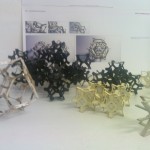
Haen Suk Yi
Presentation:
Auxetics. Global and local deformation, explored in series of models. Focusing on 3d form.
Comments:
Lida: gradient transformations local to global are happening in the 2D variant, but not in the 3D. Small for transportation, big when in use?
AY: What does it do? What does it respond to? What is the reaction? What is the point of this? What is needed when temperature is changing? What are the architectural ambition?
JR: maybe drop thermal behaviour? Look for more potential in what auxetic principles? Add other materials?
Leave a Reply